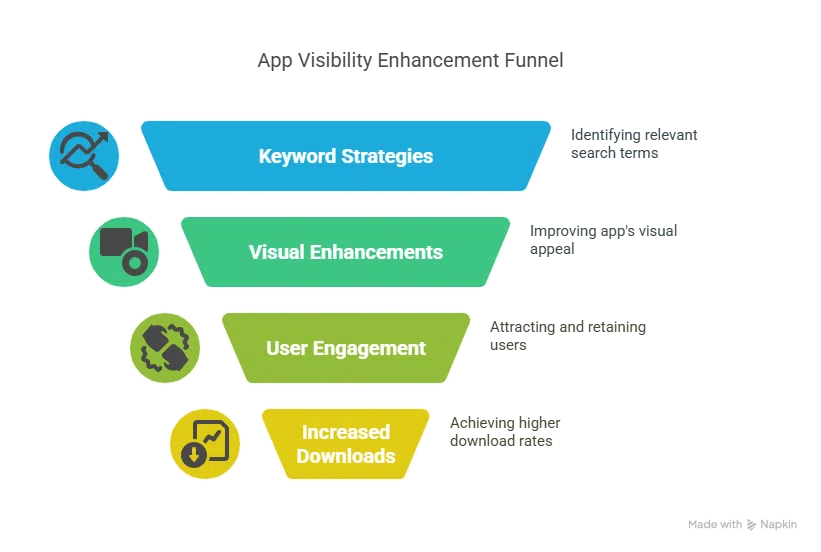Did you know that about 5 million apps are fighting for attention across the Apple App Store and Google Play? With so many choices at users’ fingertips, just launching an app isn’t enough anymore.
If your app isn’t showing up for relevant searches, it might as well not exist. That’s why you need to invest in App Store Optimization (ASO). ASO is not just a buzzword. It’s your secret ingredient to rise above the noise, attract more users, and get more downloads rolling in.
In this guide, you’ll learn how to master ASO one step at a time. From keyword strategies to visual enhancements, we’ll walk you through everything in the App Store Optimization checklist to help you boost your app’s visibility and performance in 2025 and beyond.
Understanding App Store Optimization (ASO)
Think of ASO as the SEO for your mobile app.
While SEO focuses on optimizing websites for search engines, ASO is all about enhancing your app’s visibility on leading app stores.
The primary goals of App Store Optimization include Increasing visibility, driving downloads, and boosting user engagement for your mobile application.
Keep reading to explore the best App Store Optimization tips and strategies to make your app show up at the top of search results on app stores.
Keyword Research and Optimization
Just like shortlisting target keywords for a blog post, identifying the right keywords for your app is an integral part of the App Store Optimization strategy.
Use tools like Semrush and AppTweak to pinpoint key terms people use to find apps like yours. Once you identify the right keywords, you can include them naturally in your app’s title, subtitle and description.
This way, you can increase the visibility of your app on platforms like Apple App Store and Google Play Store.
If you find focused keyword research and optimization overwhelming, consider reaching out to a professional SEO company like Stan Ventures to get things done seamlessly.
Crafting Compelling App Titles and Descriptions
Your app’s title should be clear, concise, and reflective of its core functionality.
Avoid keyword stuffing. That makes your app store content robotic and can turn users away. Instead, focus on being helpful, informative, and relatable. That’s what gets people to hit “Download.”
Create user-engaging descriptions that highlight key features and benefits and briefly explain how your app solves a problem or adds value.
When done right, these ASO optimization techniques can significantly boost your app’s user engagement.
Visual Optimization: Icons, Screenshots, and Videos
Your visuals are one of the first things users notice. Unlock their full potential by implementing the dedicated ASO techniques for visual assets. This is particularly important if you are leveraging App Store Optimization for games.
Start with your app icon. It should be simple, distinctive, and aligned with your brand. This tiny image is what users will remember you by, so make sure it stands out in a crowded app store.
Then come your screenshots. Instead of dumping random in-app images, be intentional. Use high-quality visuals that highlight your app’s key features and user interface. Each screenshot should give users a quick preview of what they will experience and, more importantly, why it matters to them.
If possible, add a short preview video. This brings your app to life, showing how it works and what makes it useful. The preview video doesn’t have to be cinematic. Just keep it clear, helpful, and engaging enough to spark curiosity.
This can prompt users to picture themselves using your app and encourage them to download it.
Encouraging Positive Reviews and Ratings
Positive reviews can do wonders for your app’s credibility. Make sure you earn them the right way.
Ask your app users for feedback after they’ve had a good experience, not right when they open the app. Keep it casual and easy to dismiss if they’re not interested.
Respond to both positive and negative reviews. A simple thank you note or a helpful reply shows users that you’re listening and that you care. This kind of engagement builds trust and encourages even more people to leave feedback.
Regular Updates and Performance Monitoring
Keeping your app updated isn’t just about fixing bugs. Regular updates tell your users that you are actively improving their experience.
Make it a habit to roll out updates that add value, whether it’s new features, design tweaks, or performance boosts.
At the same time, keep an eye on how your app is performing. Metrics like retention, crash rates, and user behavior can tell you what’s working and what needs attention.
Also, app store algorithms aren’t static. Stay on top of changes to ensure that your ASO efforts keep delivering results.
Localization and Global Reach
Going global with your app isn’t just about translating the text. It’s about making it feel native to every audience.
Think beyond language. Consider local habits, cultural preferences, and even things like color choices or imagery that resonate better in different regions.
When done right, localization makes your app feel like it’s built for every market you enter. That’s how you boost downloads, improve engagement, and reach users you might have otherwise missed out on.
By following the above App Store Optimization best practices, you are not just making your app easier to find. You are making it a huge success. Yes, you get more visibility, more downloads and better user engagement, all that you want.
Just remember, ASO isn’t a one-time fix. It’s something you have to keep refining as trends shift and user behavior evolves.
Focus on the process, keep your updates consistent, and stay tuned in to what your users are looking for. That’s how ASO becomes a reliable growth strategy.





